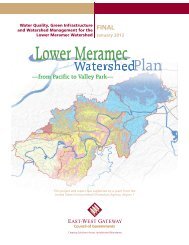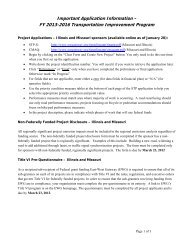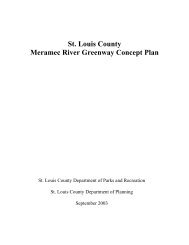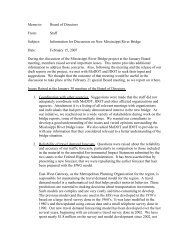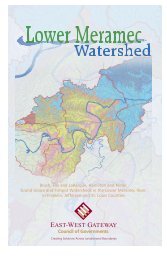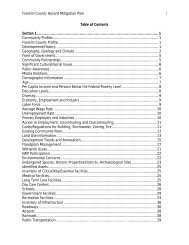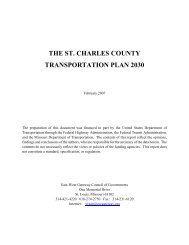Jefferson County - East-West Gateway Coordinating Council
Jefferson County - East-West Gateway Coordinating Council
Jefferson County - East-West Gateway Coordinating Council
Create successful ePaper yourself
Turn your PDF publications into a flip-book with our unique Google optimized e-Paper software.
78<br />
<strong>Jefferson</strong> <strong>County</strong> – Section 2<br />
less well understood by farmers, some farmers in the semiarid Australian climate claimed<br />
drought assistance every few years.<br />
Operational definitions help define the onset, severity, and end of droughts. No single<br />
operational definition of drought works in all circumstances, and this is a big part of why<br />
policy makers, resource planners, and others have more trouble recognizing and planning<br />
for drought than they do for other disasters. In fact, most drought planners now rely on<br />
mathematic indices to decide when to start implementing water conservation or drought<br />
response measures.<br />
In the early 1980s, research by Donald A. Wilhite, director of the National Drought<br />
Mitigation Center, and Michael H. Glantz, of the National Center for Atmospheric<br />
Research, uncovered more than 150 published definitions of drought. The definitions<br />
reflect differences in regions, needs, and disciplinary approaches. Wilhite and Glantz<br />
categorized the definitions in terms of four basic approaches to measuring drought:<br />
meteorological, hydrological, agricultural, and socioeconomic. The first three approaches<br />
deal with ways to measure drought as a physical phenomenon. The last approach to<br />
measuring drought deals with drought in terms of supply and demand, tracking the effects<br />
of water shortfall as it ripples through socioeconomic systems.<br />
Meteorological drought is usually an expression of precipitation’s departure from normal<br />
over some period of time. These definitions are usually region-specific, and presumably<br />
based on a thorough understanding of regional climatology. Meteorological measurements<br />
are the first indicators of drought.<br />
Agricultural drought occurs when there is not enough soil moisture to meet the needs of a<br />
particular crop at a particular time. Agricultural drought happens after meteorological<br />
drought but before hydrological drought. Agriculture is usually the first economic sector to<br />
be affected by drought. Agricultural drought links various characteristics of meteorological<br />
(or hydrological) drought to agricultural impacts, focusing on precipitation shortages,<br />
differences between actual and potential evapotranspiration, soil water deficits, reduced<br />
ground water or reservoir levels, and so forth. Plant water demand depends on prevailing<br />
weather conditions, biological characteristics of the specific plant, its stage of growth, and<br />
the physical and biological properties of the soil. A good definition of agricultural drought<br />
should be able to account for the variable susceptibility of crops during different stages of<br />
crop development, from emergence to maturity. Deficient topsoil moisture at planting may<br />
hinder germination, leading to low plant populations per hectare and a reduction of final<br />
yield. However, if topsoil moisture is sufficient for early growth requirements, deficiencies<br />
in subsoil moisture at this early stage may not affect final yield if subsoil moisture is<br />
replenished as the growing season progresses or if rainfall meets plant water needs.<br />
Hydrological drought refers to deficiencies in surface and subsurface water supplies. It is<br />
measured as streamflow and as lake, reservoir, and groundwater levels. There is a time lag<br />
between lack of rain and less water in streams, rivers, lakes, and reservoirs, so hydrological<br />
measurements are not the earliest indicators of drought. When precipitation is reduced or



